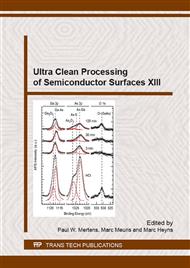p.18
p.22
p.27
p.31
p.36
p.41
p.51
p.55
p.61
Tris(Trimethylsilyl)Germane (Me3Si)3GeH: A Molecular Model for Sulfur Passivation of Ge(111) Surfaces
Abstract:
Tristrimethylsilylgermane, (Me3Si)3GeH, was employed as a molecular model compound for hydrogen terminated Ge(111) surfaces. Time and temperature dependent NMR spectroscopy yielded rate constants for the reaction between (Me3Si)3GeH and elemental sulfur and allowed for the determination of the activation energy for this molecular model reaction to mimic germanium surface passivation.
Info:
Periodical:
Pages:
36-40
Citation:
Online since:
September 2016
Price:
Сopyright:
© 2016 Trans Tech Publications Ltd. All Rights Reserved
Share:
Citation:


